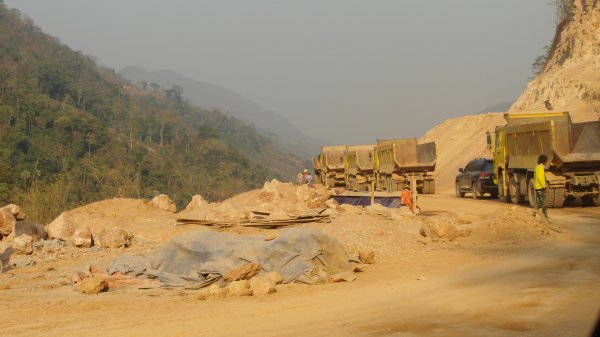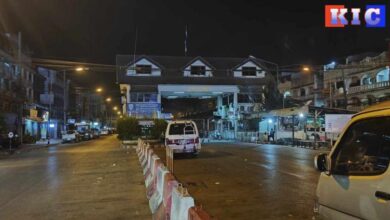Village lives bulldozed for Kunlong mega-project

A major dam and highway project in Shan State is destroying the livelihoods of locals, displacing people from dozens of villages, leading to heavy militarization in the area and contaminating water supplies, according to a human rights group.
Shan Human Rights Foundation (SHRF) has expressed grave concerns over the impacts on locals of Burma’s first dam project to span the Salween River, and a new 100 km long highway linking Burma’s town of Hsenwi through the Shan town of Kunlong to the Chinese border.
“Over 20,000 people have been affected from over 60 villages. But if you include the future construction of the road project then it could be well over 100 villages.” Sai Hor Hseng, a spokesperson from SHRF said in a phone interview with Karen News.
The Shan town of Kunlong, strategically positioned between contested ethnic areas, adjoins the Kokang and War self-administered regions and Kutkhai Township, where the Burma Army continues to mount offensives against ethnic Kachin and Palaung forces. Conflict is never far away. On 17th of December a bomb exploded near the town, killing 5, including two construction workers and a Burma Army soldier.
Kunlong residents, who rely on the Salween River for farming on water, expressed dismay and fear about the impact of the dam on their lives, including the significant Burma Army presence brought in to guard the dam. Five military battalions already keep a watchful eye opposite the town on the other side of the river, on land seized by local villagers, SHRF said. Local residents were also not seeing any work from the project, which had employed at least 500 people from other parts of the country.
A Company with a Dark Past
Asia World Company, a Burmese company with headquarters in Singapore, is carrying out the construction of the project. Asia World had been the target of U.S. sanctions since 2008 because of it’s alleged links to the heroin trade, money laundering and as a purported corporate crony of Burma’s military; allegations given further weight in a 2008 investigative report in The Irrawaddy.
“The project lacks transparency, violates local people’s rights, and is taking place in an area of active conflict. By going ahead with this massive project before a political settlement has been reached with the ethnic groups about control over natural resources, the Burmese government also risks derailing the peace process.” SHRF said in a statement to the media.
The overall project, with an estimated cost of $1.4 Billion, is a joint Sino-Burmese business venture, between Burma’s government and Hanenergy Holding Group, a Chinese company, with Asia World doing the construction. The massive dam, with 100-metre high walls, will produce an estimated 1,400 megawatts of power per year. But according to SHRF around 86 per cent, or 1,200 megawatts, will go to China, further infuriating rights groups and locals.
Villagers Pushed Aside
Since 2012, Asia World has been constructing the 100-kilometer highway from Hsenwi through Kunlong to the Chinese border. “Not only have villagers lost houses, lands and crops without compensation, but road construction has caused flooding, soil run-off into farmlands, contamination of water sources, and disruption of day-to-day village life.” SHRF said.
He was worried that the Kunlong project could set a precedent for further development projects, where local human rights were bypassed in favour of lucrative economic benefits to a select group of government officials or their cronies.
“We interviewed the local people they did not even know about the new dam. The government said it would be a new road but they didn’t mention that a dam was going to be built. This dam has no benefit to the local people. It is without transparency and accountability.” He added, “Burma [the government] shouldn’t pursue this while conflict continues.”
The construction project came as a complete surprise to the local villagers, who said that they were not informed of the project and had no say in the process. “No one came to inform us that the dam was going to be built. They just came and started working themselves… When they were surveying for the road, they just put the survey line right through people’s houses.” One local villager was quoted as saying in the SHRF report.
Adding insult to injury one elderly villager had to pay those bulldozing his home to make way for the highway, so they could flatten a new area of ground for a future home to replace the one he had lost. “They used their bulldozer to break half of my house. I told them: I can’t rebuild my house, can you level the ground for me? But the road builder answered: if we don’t get money, we can’t do it. So, I gave them 100,000 kyats (approximately US100) to level the ground, and 20,000 kyat (approximately US$20) for the bulldozer driver. So I not only lost my home, but I had to spend 120,000 kyats of my money too.”
Project Could Ignite Ethnic Conflict
Sai Hor Hseng said he was “quite sure” that there was a real risk that the project could further inflame conflict in the area, where Kachin Indepence Army (KIA), Palaung, Wa, and Burma Army forces are all in play.
Sai Hor Hseng warned that the flush of development and the pressure on locals lives would only put further strain on delicate peace talks. “Right now even though there are ceasefire, no actual political settlement has been reached so the fighting hasn’t stopped.”
“Without consulting the people and doing this before a lasting political settlement, it’ll be more confused and difficult to deal a peace because of the big projects.” He said, adding, “Because of the conflict in the area the Burmese troops have reinforced in the area. The fighting could break out anytime if they do not stop with the construction.”




